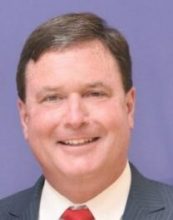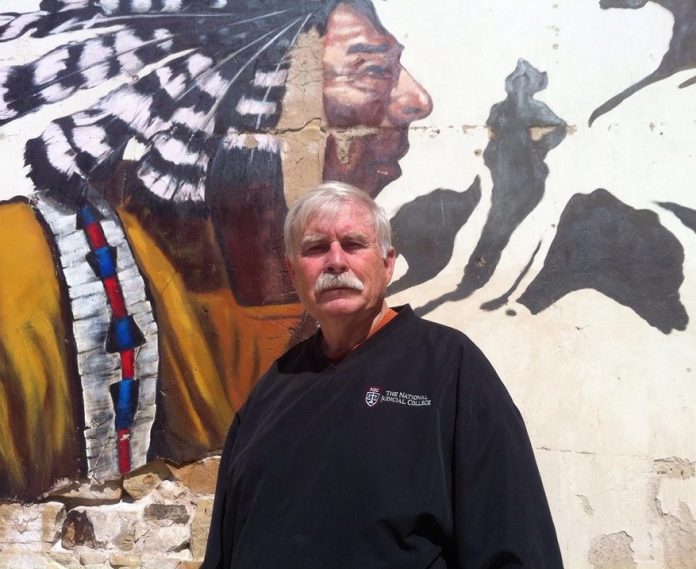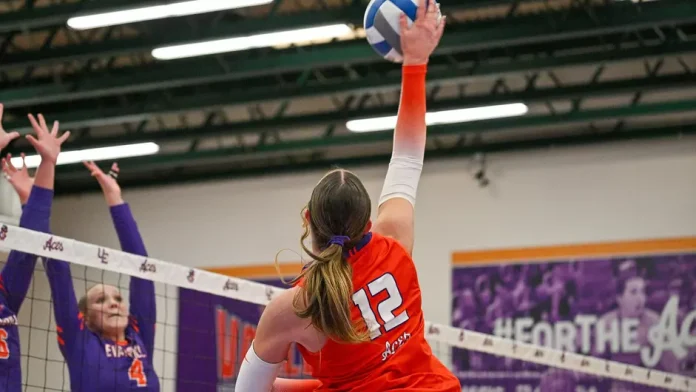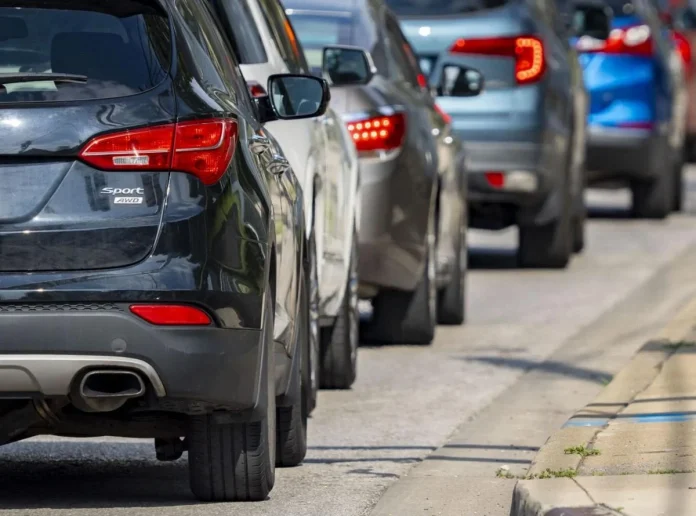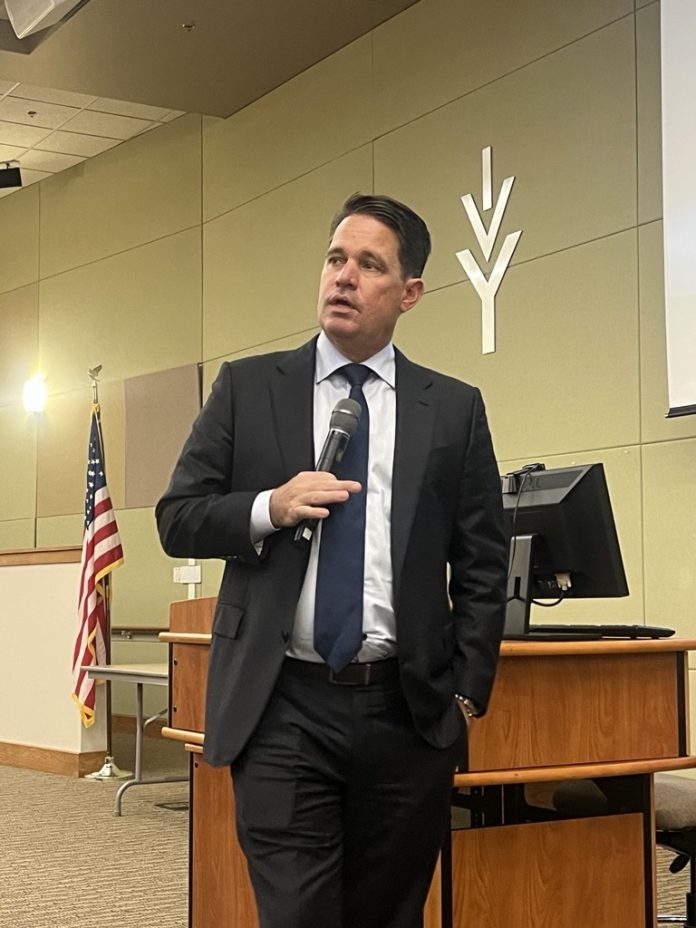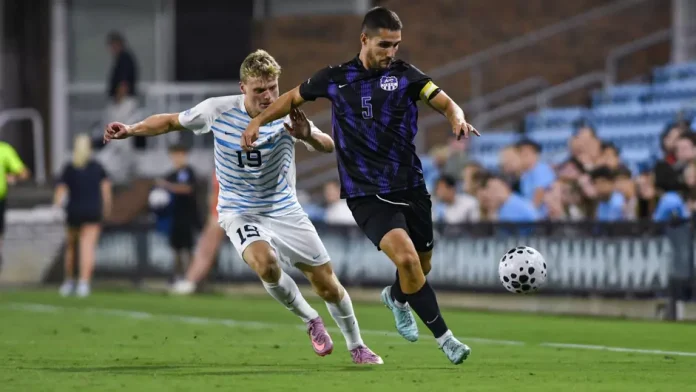Attorney General Todd Rokita leads 23-state fight to defend schools’ right to maintain sex-specific bathrooms and locker rooms
Attorney General Todd Rokita is leading a 23-state coalition in filing an amicus brief with the U.S. Supreme Court, calling on the Court to stay a Fourth Circuit injunction blocking a South Carolina school’s policy to maintain sex-specific bathrooms and locker rooms.
In the brief, filed today, Attorney General Rokita argues that policies requiring students to use facilities aligned with their biological sex are constitutional, reasonable, and essential for safeguarding student privacy and safety. The coalition challenges the Fourth Circuit’s reliance on Grimm v. Gloucester County School Board, which wrongly mandated schools to allow bathroom access based on gender identity rather than sex.
“No child should fear for their safety or privacy when using a bathroom, changing in the locker room, or showering after sports,” said Attorney General Rokita. “Forcing schools to mix boys and girls in these types of spaces shouldn’t be allowed or tolerated, and we’re going to continue fighting to stop it.”
The Fourth Circuit’s injunction stems from a challenge to South Carolina’s law requiring sex-specific restrooms and locker rooms, claiming it violates the rights of a transgender student. The coalition’s brief, citing the U.S. Supreme Court’s ruling in United States v. Skrmetti, asserts that policies applied equally to all students regardless of sex comply with federal law and do not discriminate.
This effort builds on Indiana’s leadership in a 25-state brief filed recently, supporting the Metropolitan School District of Martinsville in a similar Seventh Circuit case, reinforcing the right of schools nationwide to maintain sex-specific facilities.
The brief warns that the injunction endangers students by undermining privacy and exposes schools to liability for failing to maintain safe, sex-separated facilities. This case has far-reaching implications for schools nationwide, as similar policies face legal challenges in multiple states.
“Title IX and the Constitution empower schools to prioritize student safety and local control, not to force policies that disregard biological reality,” Attorney General Rokita added. “We won’t surrender even a single inch on this issue because enabling this madness is destructive. We need to protect kids and ensure schools can make commonsense decisions without judicial overreach.”
Attorney General Rokita remains steadfast in defending parental rights, student well-being, and local schools’ autonomy.
LET’S HEAR IT FOR MISANTHROPY
GAVEL GAMUT
By Jim Redwine
www.jamesmredwine.com
(Week of 01 September 2025)
LET’S HEAR IT FOR MISANTHROPY
Peg and I have given up requesting a restaurant table to ourselves. Regardless of the genre of eatery, the maître d’hôtel or greeter or simply the seater demands that we be seated among people we do not know or choose to associate with. The restaurant may have twenty empty tables but we are commanded to sit cheek to jowl with groups of strangers who do not appreciate our presence either. Our options are to spend our precious time and money among people we do not know and will never see again or to leave and buy groceries for a meal at home.
And should we be so fortunate as to find a sparsely occupied area when we arrive, the very next party to enter the establishment will be seated right next to us even though there may be numerous empty tables across the room. Usually such interlopers will be loud, boisterous and saddled with toddlers who spend their time letting their parents or grandparents know how unhappy they are.
Having been a waiter myself in various establishments in various locales, I know it requires very little extra effort to serve parties a few extra yards apart. In fact, I always preferred a little extra space between my customers who appreciated the same.
Another phenomenon I have noticed when dining out is that servers demand that we pay personal attention to them when all we want to do is enjoy our chosen company, order our meals and ask for the check later. We cannot reasonably do anything about a bad meal except not come back, so why are we asked ad nauseum, “Is everything okay?” If it isn’t, will we be reseated by ourselves? And why do the waiters or waitresses demand eye-contact and verbal responses? How about just a little privacy? With even a hamburger costing $40.00, is a little peace and quiet out of the question?
Of course, the real problem is not being seated cheek to jowl in restaurants, but being constantly accosted by other humans who are in constant fear of being judged irrelevant and, therefore, ignored. Everyone wants their own space and time, but they resent it if the rest of us want the same thing. Most people would rather be horsewhipped than be deemed insignificant. It is preferable to be abused instead of dismissed.
Even when Peg and I visited the two-million-acre Yellowstone National Park in early May when hardly anyone else was anticipated to be there, as we were enjoying the grand solitude of awaiting the eruption of Old Faithful, a bus load of clamoring tourists arrived. They exited the tour bus like a hoard of yellow jackets with cameras. Then as Peg stood trying to watch Old Faithful erupting, a man, without saying a word, leaned his elbow upon her shoulder with his camera in hand to video the event. It is fortunate for him the national parks prohibit guns.
Gentle Reader, you might ask why those who prefer some space and privacy ever leave home? It is because modern society gives us no option. In a world with over 8 billion people crammed all over it, any respite from the cacophony of clanging culture is like a poultice of blessed ointment, a surcease of soothing balm from Gilead. But, one can only escape into Amazon for so much. Some things in our lives require forays where providers require our physical presence. Those halcyon days of family doctor house calls, home repairs, disaster recovery and neighbors fixing our fences without notice are gone with the arrival of the questionable benefits of electricity.
Where are the neighbors and friends who, much as ideal children are neither seen nor heard until and unless they are truly essential. Is it not bad enough that we must fight our way through crowded streets, jostling airport queues, sardine seating on multi-hour flights and put up with clowns who pay for seats at ballgames and concerts then never sit down even if they are in a front row?
And who are the sadists who design airplane seating with three seats and four armrests? If we are required to pay exorbitant ticket prices we should, at least, never have to share armrests with total strangers. One row of only two separate seats ought to be mandated by federal law. Plus, the overhead bins should have available space for the maximum two passengers per row carry-ons. Don’t the people who design airplanes ever fly themselves?
Assigning blame for those who demand we are subjected to unwanted socialization is difficult. It may have begun with grade school curricula that force six-year-olds to mingle even if bacteria are the only thing truly exchanged. Or, perhaps, our own parents are to blame for constantly placing us in social settings where the supposed benefits are sharing and familiarization even if what is shared is contact with unwashed comrades. Do adults have such little faith in children they fear their individuality?
Of course, what most of us would love to avoid is the insipid political philosophies of those with whom we disagree. I suggest it is time the TV pundits and gratuitous sociologists who keep harping on “togetherness” simply shut up and leave us alone. I for one would be happy to afford others their clearly illogical political positions if they would reciprocate.
In conclusion, Gentle Readers, whether you are customers or providers, let’s just strive to leave others alone and hope they do the same.
P.S. from Peg: “Geesh, what a grump? Which side of the bed did Jim get out on this morning?”
For more Gavel Gamut articles go to www.jamesmredwine.com
Aces battle to the finish in opener
Butler takes 3-1 victory
EVANSVILLE, Ind. – Freshman Hinsley Everett led the University of Evansville volleyball team with 11 kills in her debut as Butler took Friday’s opener of the Butler Big Dawg Kickoff inside Hinkle Fieldhouse.
Everett added six digs and two service aces. Chloe Cline recorded 10 kills to go along with a team-high six blocks while McKenzie Laubach finished with eight kills. Ainoah Cruz led the Aces with 22 digs while Kendall Agler had 10. Kora Ruff led the way with 36 assists. Butler was led by Aaleh Tolliver’s 15 kills.
Game 1 – Butler 25, UE 23
Evansville jumped out to a 3-0 lead out of the gate. Carlotta Pascual Centelles opened with a kill while Everett registered an ace. UE continued to hold the lead at 5-2 before the Bulldogs utilized a Tolliver kill to get within one at 6-5. Another kill by Pascual Centelles saw UE go up 9-7 before Butler scored a pair to tie the set at 9-9.
After UE retook an 11-9 lead, the Bulldogs made their move scoring four in a row to take their first lead at 13-11. Evansville forced multiple ties leading to an 18-18 score. Two errors by BU put the Aces back in front at 20-18, but another run by Butler saw them rally for the 25-23 win.
Game 2 – Butler 25, UE 18
Following their victory in game one, the Bulldogs opened the second set on a 3-1 run before extending the lead to 13-7. UE refused to give up as two kills from Laubach highlighted 5-2 run that made it a 15-12 game. Unfortunately, Butler fended off the challenge and pulled away to take the set by a final of 25-18.
Game 3 – UE 25, Butler 21
Another quick start saw BU open a 3-1 lead before a kill by Ryan Scheu knotted the score for the first time at 6-6. With the set tied at 9-9, a kill from Cline gave UE its first advantage. After the Bulldogs tied it back up at 10-10, the Aces scored the next two points and would pull away to take the set.
A block from Ruff and Cline solidified a 12-10 advantage while the lead reached three (18-15) on a Scheu kill. The Bulldogs cut the deficit down to a pair before the Aces finished strong with a Laubach kill clinching the set.
Game 4 – Butler 25, UE 23
Maddie Hawkins recorded a service ace that put Evansville in front at 7-5 while a spurt in the middle of the set pushed the lead to 13-10 with Josdarilee Caraballo picking up a kill. Butler fought back to tie the game at 14-14.
An ace from Ruff put the lead back in UE’s hands at 17-16, but the Bulldogs scored the next three points to take the lead for good as they clinched the match with a 25-23 decision. Evansville faces Middle Tennessee State at 9 a.m. CST on Saturday before facing Purdue Fort Wayne at 1 p.m. CST.
HOT JOBS
|
|||||||||||||
|
|||||||||||||
|
|||||||||||||
|
|||||||||||||
|
|||||||||||||
|
|||||||||||||
|
|||||||||||||
|
|||||||||||||
|
Trump’s EPA wants greenhouse-gas rules gone—what’s that mean for Indy?
Indianapolis could see hotter days and more rainfall if the head of the Environmental Protection Agency gets his way.
Earlier this summer, the EPA’s leader, Lee Zeldin, chose Indianapolis to announce plans to roll back regulations for greenhouse gas emissions.
But one former deputy administrator for the agency sees a major problem: In a state like Indiana, which already has limited environmental regulations, the EPA sets the standard.
“So, if the federal standards no longer control greenhouse gas emissions, there will be no greenhouse gas emissions requirements here,” Janet McCabe told Mirror Indy.
Zeldin wants to undo a ruling from 2009 that serves as the basis for rules limiting greenhouse gases from vehicles, power plants, the oil and gas industry and other sectors.
McCabe, who served as deputy administrator for the EPA from 2021 to 2024 under the Biden administration, said it’s important that Hoosiers have what she calls the “federal minimum.”
She spoke to Mirror Indy about what Zeldin’s plan would mean for Indianapolis.
Why does it matter what the EPA does?
If the EPA doesn’t regulate greenhouse gas emissions, chances are Indiana won’t either.
According to McCabe, EPA standards are designed to be the baseline level of protection for health and the environment. Environmental laws, like the Clean Air Act and Clean Water Act, were written so states have the ability to pass more protective rules and laws.
But some states, like Indiana, have made it more difficult for that to happen, so federal rules end up becoming the state’s rules by default.
“If there’s no federal power plant greenhouse gas regulation, then there won’t be one in Indiana,” McCabe said, “and same for oil and gas and landfills and that sort of thing.”
Indiana lawmakers passed a law in 2016 preventing the state’s environmental rules board from adopting any standard or law that is more strict than a similar regulation or standard under federal law.
Earlier this year, Republican Gov. Mike Braun issued an executive order that prohibits the adoption of any new environmental rules, regulations or programs more stringent than federal requirements unless explicitly required by state law or deemed necessary by Braun’s office.
Besides attempting to eliminate regulations on greenhouse gases, the EPA is also trying to stop collecting and releasing information about the emissions from getting to the public.
It already stopped publicly releasing a yearly report on greenhouse gas emissions, and it is planning to eliminate long-standing requirements for polluters to report their emissions. Plus, the EPA plans to allow the destruction of a satellite that tracks carbon dioxide emissions and crop health.
“You just will not know if you’re making a difference if you don’t have a way to measure it in a way that people will feel confident about and in a way that’s made public to people,” McCabe said. “So, if they no longer require people to report their greenhouse gas emissions, that will be a huge loss.”
More rain and hospital visits
Greenhouse gases—such as carbon dioxide, methane and nitrous oxide—harm human health and speed up changes to the earth’s climate by trapping heat in the atmosphere.
Carbon dioxide, for example, comes from vehicle exhaust, coal-fired power plants and the manufacturing of products such as cement, metals and chemicals. The gas accounts for about 75% of all greenhouse gas emissions and stays in the atmosphere for hundreds of years after it is emitted.
Other greenhouse gases include methane and nitrous oxide.
Not only do greenhouse gases trap heat, but in large concentrations, they can also lead to respiratory problems and other health impacts.
A study led by Purdue University in 2018 found that climate change, which is accelerated when more greenhouse gases enter the atmosphere, has made Indiana about 1.2 degrees hotter and caused about 5.6 inches more rain to fall a year.
Increased rainfall has already cost billions of dollars. Citizen Energy Group’s $2 billion DigIndy Tunnel System was constructed to hold more stormwater and rainwater than the city’s old combined sewer system, which had allowed both to pollute local waterways.
And increased heat has negatively impacted air quality, which has led to more hospital visits and even premature deaths.
According to the Purdue study, the impact of both heat and rainfall would be worse if greenhouse gas emissions were to go unregulated.
It estimates that the state’s annual average temperature would rise about 6 degrees by 2050 with high greenhouse gas emissions, and up to 10 degrees by the end of the century.
By mid-century, Indiana will likely see up to 8% more rainfall than it averaged in the recent past. By the end of the century, there will likely be less snow and more rain will fall in the winter and spring.
What are the largest sources of greenhouse gases in Indianapolis?
Marion County’s biggest greenhouse gas problem comes from cars and other vehicles.
Every day, vehicles travel 38 million miles in Marion County, according to the Indiana Department of Transportation. The average vehicle emits 400 grams of carbon dioxide equivalent emissions per mile.
Only about 26,000 out of the 6.1 million registered vehicles in the state are electric-only, so that means that vehicles emit approximately 15,000 metric tons of carbon dioxide in Marion County per day.
In a year, that’s about 5.5 million metric tons—as much as about 14 natural gas plants would put out in a year, according to the EPA’s Greenhouse Gas Equivalencies Calculator.
Indianapolis also gets a large amount of greenhouse gas emissions from 11 facilities, which are mainly in the southwest portion of the city.
According to their reports to the EPA, the plants together emitted 2.8 million metric tons of carbon dioxide equivalent, the same emissions you get driving 650,000 gas-powered vehicles for a year.
The largest emitter is AES Indiana’s Harding Street Station, a natural gas-fired power plant, that reported emitting 1.7 million metric tons of carbon dioxide equivalent emissions in 2023.
The next highest emitter is the Reworld solid waste facility, formerly known as Covanta Energy, which incinerates Indianapolis’ municipal trash. The facility emitted 355,000 metric tons of carbon dioxide equivalent emissions in 2023.
New Ivy Tech President Visits Evansville for Listening Sessions
EVANSVILLE, Ind. – Ivy Tech Community College’s new president’s 65th day went about like the rest of his days at Ivy Tech since his official first day July 1.
He listened.
Ivy Tech Evansville welcomed Dr. Marty Pollio, the 10th president of Indiana’s statewide community college system, to campus yesterday (Aug. 27) as part of his “100 Days of Listening, Learning and Leading” plan. The plan is designed to build relationships with students, faculty, staff and community partners across the state and chart a clear path forward for Dr. Pollio as he ensures Ivy Tech’s alignment with Indiana’s educational and workforce goals.
Dr. Pollio spent Wednesday afternoon and evening in listening sessions with the Evansville campus faculty, staff and area community members, gathering information about what’s working, what could be improved, and suggestions for Indiana’s Community College.
“We appreciated the opportunity to connect employees and community members with Dr. Pollio to provide feedback on what is working well and what we need to do to forge the future. These listening sessions are invaluable in ensuring Ivy Tech continues to serve our communities and change the lives of our students,” said Chancellor Daniela Vidal.
Pollio shared that among the many things he is learning on his campus visits, his top desire is a “focus on quality and customer satisfaction.”
“As Indiana’s community college and workforce engine, Ivy Tech must stay closely connected to the people and communities we serve,” said Dr. Pollio. “Listening directly to students, employers, and community partners helps us better understand their evolving needs and challenges and ensures we deliver education and training that meet today’s demands and anticipate tomorrow’s opportunities.”
Dr. Pollio started visiting campuses and communities in the southern part of the state prior to his official start date of July 1, 2025.
As president of Ivy Tech, Dr. Pollio serves as the chief executive officer of Indiana’s largest public postsecondary institution, which enrolled more than 200,000 students in the 2024-25 academic year. Dr. Pollio champions the implementation of Higher Education at the Speed of Life, the College’s strategy to deliver 50,000 annual credential completions aligned with the needs of Indiana’s workforce. He leads a team of nearly 7,000 faculty and staff across the College’s 19 campuses in Indiana and online and oversees major institutional initiatives that strengthen academic quality and improve student retention, completion, employment and transfer outcomes.
Dr. Pollio joined the College on July 1, 2025, after a nationally recognized tenure as superintendent of Jefferson County Public Schools (JCPS), one of largest urban public school districts in the United States. In his eight years of leadership, JCPS increased its high school graduation rate and nearly doubled its postsecondary readiness rate while reducing achievement gaps.
Central to Dr. Pollio’s educational philosophy is a deep commitment to preparing students for success at work and in life. At JCPS, he directed the Academies of Louisville, a nationally recognized initiative that embedded career pathways into the high school experience. He previously led similar efforts while serving as principal of Jeffersontown and Doss high schools, where he drove improvements in student achievement by bridging academic instruction with hands-on, work-based learning opportunities.
Dr. Pollio holds a Bachelor of Arts in Education from Indiana University, a Master of Science in health education from Eastern Kentucky University, and a Doctor of Education in educational leadership and Management from the University of Louisville. He took office on July 1, 2025.
EPD DAILY ACTIVITY REPORT
FOOTNOTE: EPD DAILY ACTIVITY REPORT information was provided by the EPD and posted by the City-County-County Observer without opinion, bias, or editing.
Evansville Battles, But Comes Up Short at No. 15 North Carolina
CHAPEL HILL, N.C. – The University of Evansville men’s soccer team played the 15th-ranked North Carolina Tar Heels tough, but dropped a 2-0 decision on Thursday night in Chapel Hill.
The two sides went back-and-forth throughout the first 45 minutes, but neither team was able to break through before the half. Armon Haghighat (Irvine, Calif./Irvine Valley CC) had the best scoring chance for Evansville, putting a shot on target off his left foot, but a great save by the UNC keeper kept his clean sheet intact.
The score remained even through the first 25 minutes of the second half, with Evansville taking one shot and North Carolina taking two. However, the Tar Heels were able to put the first goal of the game on the board in the 70th minute before scoring again in the 75th minute to pull away for a 2-0 win.
“We’re disappointed to lose the match, but to compete against UNC the way that we did, especially for the first 70 minutes of the game, I think we’re proud about the effort.” Head Coach Robbe Tarver said postgame.
“We talk a lot about intangible moments, and you’re just going to have to perform those consistently to compete against a team like UNC, and I thought we did that.”
Martin Wurschmidt (Stavern, Norway/Thor Heyerdahl VGS), Nacho Garcia (Zaragoza, Spain/UNIR) and Haghighat tallied shots for Evansville. North Carolina out-shot Evansville 12-3 overall.
With the loss, Evansville moves at 0-1-2 on the year. The Aces return home on Sunday, hosting Memphis at Arad McCutchan Stadium for Alumni Weekend and a celebration of legendary UE head coach Mick Lyon.



